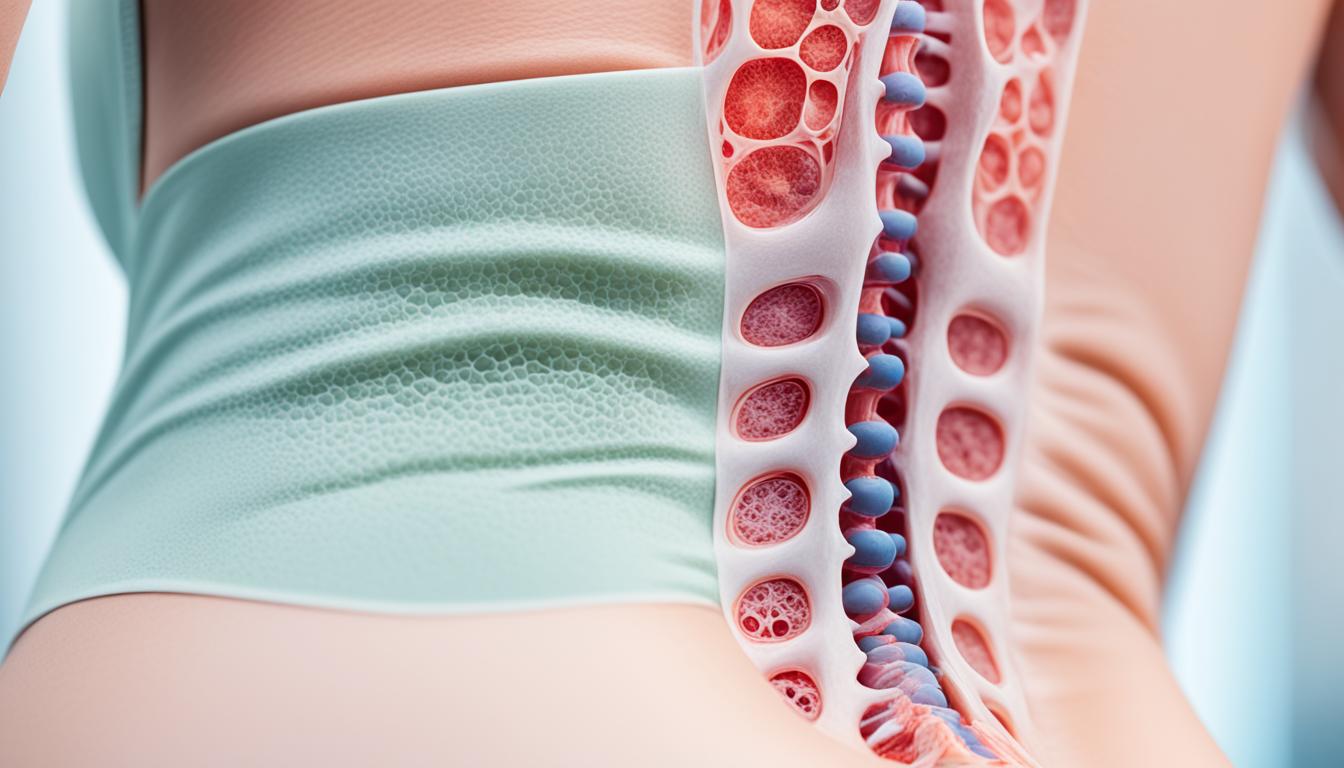Sacral dimple disease is when there’s a small dip at the base of the spine. It’s usually there from birth. Most times, it’s not a big issue. But, it might mean there are problems with the spine or bone. The exact cause isn’t known for sure. But, doctors think it happens when the baby’s spine doesn’t develop fully in the womb.
Doctors usually spot a sacral dimple during a checkup. They look at its size, shape, and where it is. They also check for any unusual skin signs. They might do tests like ultrasound or MRI to see if there are spine or bone issues.
Sometimes, people need surgery to fix the spine or bone problems with sacral dimple. But, there’s a new way to treat some similar conditions. Stem cell therapy shows a lot of hope in treating issues like spina bifida.
Key Takeaways:
- Sacral dimple is a condition characterized by a small depression at the base of the spine.
- It is often harmless but can be associated with underlying spinal cord or bone abnormalities.
- The exact cause of sacral dimple is unclear, but it is believed to be a result of incomplete fusion of the neural tube during fetal development.
- Diagnosis is typically done through physical examination and imaging tests such as ultrasound, X-ray, and MRI.
- Surgery may be required to correct any underlying issues, but stem cell therapy has shown promising results in treating related conditions like spina bifida.
Symptoms and Complications of Sacral Dimple
Sacral dimple is when there is a small dent or pit at the base of the spine. It’s quite common and usually not a big deal. But sometimes it can show there are issues with the spine or bones. This might lead to more serious problems.
Signs of sacral dimple are:
- A small dent or pit at the lower back
- Hair grows around the dimple
- There may be a tiny piece of skin that hangs off near it, a skin tag
Complications from sacral dimple vary. But they might include:
- Getting infections there is more likely. So it’s important to keep the area clean to avoid this.
- Sometimes there are spinal cord issues, like tethered cord syndrome. This can cause lower body pain, or feeling numb or weak.
- A sacral dimple could mean the spinal cord is pulled or stretched, which may cause problems with moving.
- Neurological issues are possible. This might lead to leg weakness or even paralysis.
Checking newborns and kids with a sacral dimple is very important. If there are signs of problems, a doctor needs to look at it. They can help find out what’s going on and how to handle it.
| Symptoms of Sacral Dimple | Complications of Sacral Dimple |
|---|---|
| A small depression or pit in the skin at the base of the spine | Infections |
| Hair growth or tuft of hair near the dimple | Spinal Cord Abnormalities |
| An accompanying skin tag | Tethered Spinal Cord |
| Neurological Deficits |
Causes and Diagnosis of Sacral Dimple
The cause of sacral dimple is not fully known. It’s likely caused by the spinal cord not closing completely when a baby is in the womb. Both genes and the world around us might play a part in this issue.
To diagnose a sacral dimple, a doctor will look closely. They will check the dimple’s size, shape, and where it is. They will also search for any skin problems around it.
More tests like ultrasound, X-ray, and MRI might be needed. This is if the doctor suspects there are problems with the spine or bones. These tests show what’s going on inside and can spot complications.
There might be blood and genetic tests as well. These are to check for any genetic disorders linked to the sacral dimple. They give clues about if more issues might be present and what to do next.
All in all, a mix of physical exams and tests is key to diagnosing sacral dimple. This approach helps spot the cause accurately. Then, doctors can choose the best way to help those with sacral dimple.
Conclusion
Sacral dimple is a usual condition. It shows as a small dip in the skin at the bottom of the spine. Most of these dimples are not a worry and don’t need any specific treatment. Yet, it’s key to keep an eye on them. We should check for any issues with the spinal cord or bones that could cause problems.
If there are other problems, surgery might be the answer. But, new treatments like stem cell therapy are now offering hope. They are promising for dealing with conditions like spina bifida, which is related to sacral dimples.
Stem cell therapy is showing great promise. It could help fix damaged tissues. Plus, it might make movements better. This can lead to a better life for those with this condition. Researchers are still looking into how useful this therapy can be in the long run.

